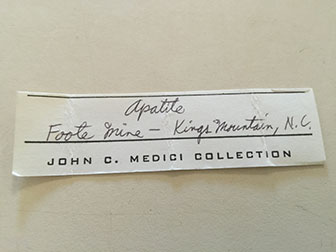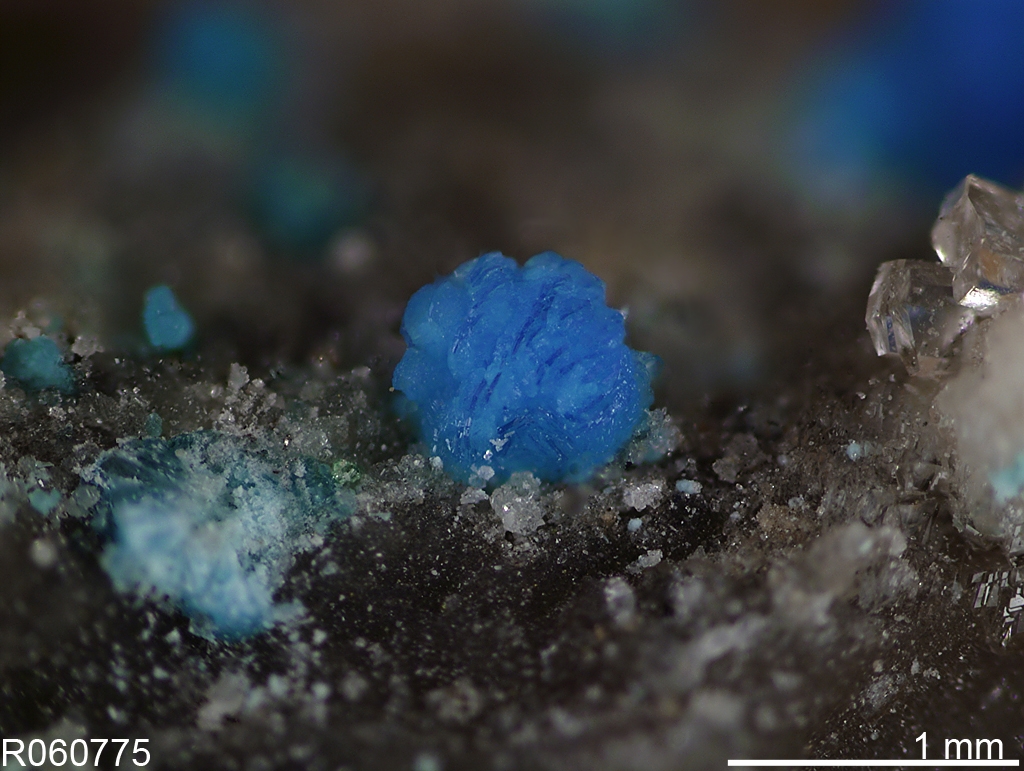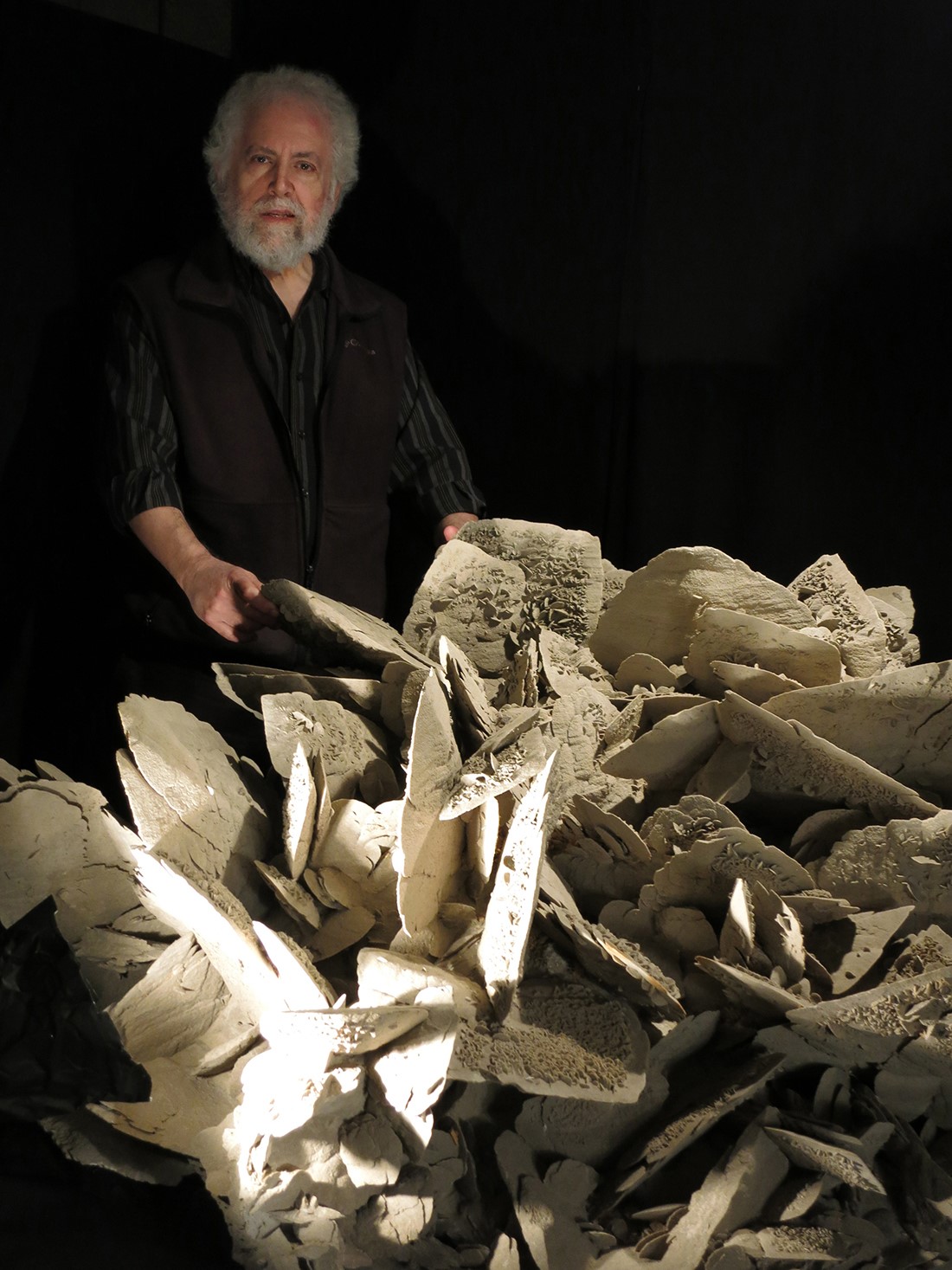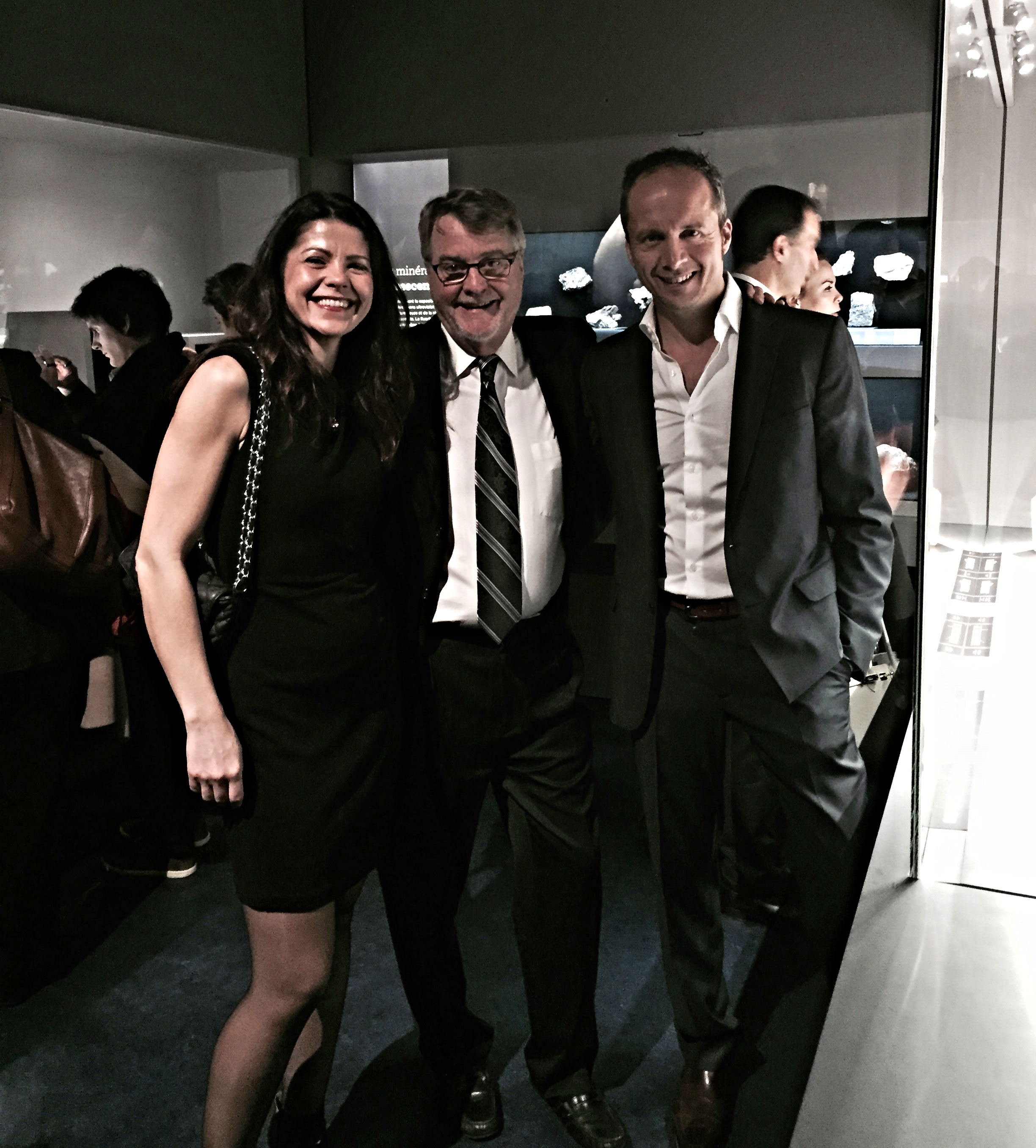April 2016
Table of Contents
Shows and Events
Pala International News
Minerals and Mineralogy News
Industry News
Pala Presents
Recycle Bin
Editor: David Hughes
Shows and Events
Mineral & Gem à Sainte-Marie-aux-Mines: June 23–26, 2016
The 53rd Sainte-Marie show will be held June 23–26, with the first two days limited to trade only. This year, Bill, Will and Carl Larson will attend the show along with friend and fellow gem dealer Mark Kaufman.
Details are yet to be finalized, but here's what we know so far.
As was presented last year, a symposium is offered on Friday at 3:00 p.m. The topics are (from the French version of the website; English not yet updated from last year):
- "Wine & Stone: An Australian Story" by Penny Williamson, geological curator at the School of Earth and Environmental Sciences, University of Wollongong (Australia)
- "The French Crown Jewels" by Eloïse Gaillou, Assistant Curator at the Museum of Mineralogy MINES ParisTech
- "Earth Treasures: Story and Achievement of an Exhibition" by Cristiano Ferraris, Curator at the National Museum of Natural History in Paris
- "Mineral Collections: The Harvard History" by Raquel Alonso-Perez, curator at the Mineralogical and Geological Museum of Harvard University
The following lectures also will be presented.
- "Emerald: Treatment, Detection, Evaluation" in French by Pierre-Yves Chatagnier & David Goubert, dealers in precious stones, Thursday, 11 a.m.
- "Color Tourmalines" in German or French by Paul Rustmeyer, Dr. of Chemistry, Friday, 11 a.m.
- "Jade, This Beautiful Unknown" in French by Caroline Tran Vinh, gemologist, Saturday, 11 a.m.
- "The French Crown Jewels"—this time in French—by Eloïse Gaillou, Assistant Curator at the Museum of Mineralogy MINES ParisTech, Saturday, 1:30 p.m.
- "Meteorites and Their Impact" in French by Alain Carion, Sunday, 11:00 a.m.
Finally, our good friend and mineral dealer Alain Martaud curates The Prestige Exhibition, this year entitled Origins: Stones and Wines. Humans have had relationships with precious stones and the fruit of the vine in liquid form for millennia. Both being products of the land, they are brought together in this exhibition, loosely based on Flashes of Colour: Legendary Wines and Gemstones from 2007. The origin of their color is presented along with the effect of land on grapes (part of what oenophiles call terroir). And the fact that some mineral specimens come from the land of vines also will be highlighted. See the Prestige page (in French) for a photo by Mia Dixon, Pala International's resident photographer.
Pala International News
Pala's Featured Specimen: Hope You Have an Apatite
This time we feature a crystal of apatite perched right on top of the quartz matrix. Measuring 2.6 cm x 1.5 cm x 2 cm, the main apatite crystal is 1.5 cm x 1.3 cm. This is rather large for the locality and is quite a deep purple.
Apatite on quartz from North Carolina. Price available upon request. (Photo: Benjamin deCamp)
The apatite is ex John C. Medici Collection. It comes from Foote Lithium Co. Mine, Kings Mountain District, Cleveland Co., North Carolina, USA. It would be great for any collector of American rarities.
Interested? Contact us.
Mineral and Mineralogy News
Rarer Earth: Of Vampires and Volcanoes
Robert Hazen of the Carnegie Institution was in the news again (see "Calling All Collectors" from our last edition), this time announcing the cataloging of 2,500 of the Earth's rarest minerals with Jesse Ausubel of Rockefeller University. Out of the known 5,000 mineral species, less than 100 make up nearly all of the Earth's crust, Hazen told BBC News. That leaves 4,900 rare species; 2,500 of those are extremely rare. Of that latter number no species can be found in more than five places on the planet.
Nevadaite, above, is only known to occur in just two locations: Eureka County, Nevada, and a copper mine in Kyrgyzstan. (Photo: Robert Downs, University of Arizona)
Hazen says that rare minerals are of interest to scientists for several reasons. They demonstrate how our planet is different from others. That is because many minerals would not occur were it not for biological forms. For a somewhat comical instance, hazenite (named after Hazen and discovered by one of his former students) is caused by microbes living in California's Mono Lake. When the lake has been dry for some time, phosphorus levels can move the microbes to defend themselves by excreting hazenite crystals: a crystalline poop. "Hazenite happens," says Dr. Hazen.
For some of these rare minerals, their "life" can be fleeting. Edoylerite, metasideronatrite, and sideronatrite are vampire-like, decomposing when exposed to light. Hazen says that fingerite is like a "perfect storm of rarity," somewhat tongue-in-cheek. It forms on the sides of El Salvador's Izalco Volcano under extreme conditions that require a delicate balance of elements—and it dissolves in the rain.
A report on the cataloging effort is to be published soon by American Mineralogist (see abstract here).
Museum News
Below, six items from the wide, wide world of museum mineral and gemstone collections.
AMNH Loses a Crystal
On Friday, January 22, 2016, an historic specimen of elbaite tourmaline went missing from the mineral collection of the American Museum of Natural History. It is from the Gillette Quarry at Haddam Neck, Connecticut and was stored with a group of 27 others. It appears to have been stolen, so dealers and collectors should be on the lookout. If you have any information, please contact George Harlow or Jamie Newman.
The missing specimen is a single-crystal of elbaite measuring 5.6 x 1.1 x 0.9 cm with a green body and red-pink termination. A paper label with the catalog number 98718 was glued to the crystal.
Pala International suggests that whoever has this specimen could undo the irrevocable harm to the collection by returning it to the museum by mail.
theNAT Loses a Natural
Michael W. Hager has a long career in the field of museums. Before his twenty-five years as President and CEO of the San Diego Natural History Museum (theNAT), he was director of the Museum of the Rockies (1978–1989) and of the Virginia Museum of Natural history (1989–1991). And he's been moonlighting since 1998 as president of CinemaCorp of the Californias, which produces educational films. "Mick" Hager has a specialty in paleontology, but more important for theNAT, he also specializes in strategic planning and development. He took the museum from sixty employees with a budget of $2.1 million to a staff of 150 and a $13 million budget, not to mention 800 volunteers. And it seemed natural to him—"a no-brainer"—to focus on Southern and Baja California, which would bring wide attention to the museum and its adjunct institutions.
Hager retires June 30 at the age of 73. To the public he'll be remembered for exhibitions like All That Glitters and Dead Sea Scrolls, which he calls "the largest comprehensive exhibit of scrolls in the world."
Read more in this profile of Mick Hager in The San Diego Union-Tribune.
Glittering in Golden
Amid the other September gem and mineral shows, visitors to the Denver Fine Mineral Show, held each year in Golden, find themselves quite near to what was recently called a "hidden gem," at Golden's Colorado School of Mines. On February 18, the Denver Post profiled the school's Geology Museum, contrasting it with Denver's Museum of Nature and Science. The latter institution offers a broad natural history. The Geology Museum focuses on geology and mining history—a history brought to light by six murals painted for the 1939 Golden Gate International Exhibition in San Francisco by Irwin D. Hoffman, whose Mexico etchings recall the photography of Tina Modotti.
The museum website states that it "serves as the state repository for Colorado's mineral heritage and promotes its importance and understanding to the university community and the public." As well as featuring some of its collection of fifty to sixty thousand items, the museum has a Special Exhibits Room to which visitors from the mineral show are known to contribute. Be sure to pencil it in on your calendar for this year's Denver show.
From Northeast to Southwest
The Mineralogical and Geological Museum at Harvard University continues its exhibit in Tucson at the University of Arizona Flandrau Science Center and Planetarium. American Mineral Heritage: The Harvard Collection features selections from the oldest university mineral collection in the United States.
Among the beauties on loan are gold specimens, of course, such as that pictured here. Also, two specimens of morganite beryl: the 30-cm-wide "Rose of Maine" and 7-cm-wide "The Peach."
The "Fleur de Lis" is displayed as well: a burgundy-colored elbaite tucked into a bed of white albaite with a quartz crystal for a pillow. (It's the banner for the Flandrau's page on the exhibition.)
American Mineral Heritage remains on view through 2016. Museum information is available here.
Meanwhile, the Harvard museum itself received a loan of what is thought to be the largest cut red taaffeite in the world, 0.58 carats, from the collection of Jon Sigerman, who is among other things, a traveling pal of Pala International's Bill Larson. It was on such a trip with Bill that Jon purchased the stone in Bangkok. The taaffeite is at Harvard for research but also for display, in the Earth and Planetary Science Gallery.
The Peach. This specimen was found in 1989, according to a chapter on the Bennett Quarry in A Collector's Guide to Maine Mineral Localities, by W. B. Thompson, D. L. Joyner, R. G. Woodman, and V. T. King, available online. The above image comes from "Appraising Harvard Redux," in which Pala International's Bill Larson recalls the highlights during his valuation of the mineral collection at Harvard last summer. (Photo: Bill Larson)
As explained by Renée Newman (Rare Gemstones, 2012, 114), taaffeite is named after Count Taaffe, a gemologist from Dublin who found the first cut stone in a jeweler's junk box in 1945. It could have been mistaken for a mauve spinel, but it was doubly refractive, unlike spinel. A lab in London determined it was a new mineral. This was the first identification of new material from a faceted specimen.
And a Carbonite Display?
Peabody Director David Skelly and David Friend prepare to strike the first blows in the demolition phase of construction. (Photo: Sally Pallatto)
Another Ivy League school began work in late February on a major makeover in its own museum: renovation of the Yale Peabody Museum of Natural History auditorium into a state-of-the-art mineral and gem gallery and multipurpose space. David Friend (Yale '69), has given a $4 million gift for the construction, which he hopes will "raise interest in Earth science to a whole new level." As well as showing off massive crystals from the Peabody collection, the David Friend Hall displays will be backdrop to lectures, classes, dinners and special events. Friend, the cofounder of Carbonite (and of ARP Instruments, maker of the old ARP 2600 synthesizer your editor used as a young man), will in time create an endowment to support displays and programming. The original gift includes an allowance for the acquisition of new specimens; Friend has loaned items from his personal collection as well.
The auditorium on the Peabody's third floor was created in 1963 out of a space originally displaying minerals and gems. The Peabody's Division of Mineralogy and Meteoritics has a holding of more than 40,000 specimens and 400 meteorites. In the end, the hall still will allow for function as an amphitheater. For more on the project, see "Sharing a Passion for Minerals."
Artist rendering of the David Friend Hall. (Photo: Yale Peabody Museum)
Richard Berger with the selenite rose from his Masterpieces of the Earth Collection. It is one of the massive crystals that will anchor the David Friend Hall. (Photo: Casper Beesley)
Hart Shaped World
Visitors to world-class mineral and gem shows are no stranger to Alan Hart, who is Principal Curator of Gems and Minerals at London's Natural History Museum. The following Gem-A announcement tells of Hart's new position.
The Gemmological Association of Great Britain (Gem-A) has announced the appointment of Alan Hart FGA DGA as the Association's new CEO. A former member of the Gem-A Council, Hart is currently Head of Earth Sciences Collections at the Natural History Museum, London. With a wealth of experience in the gem and mineral trade, Hart started his career at the Natural History Museum in 1981 as Assistant Minerals Scientific Officer, progressing to his current position of Principal Curator of Gems and Minerals and Head of Earth Sciences Collections in 2012. Hart is Chair of the Museum's Collections Committee and serves on various science executive boards, providing strategic and operational goals to improve standards, best practices and operational efficiencies.
Of his appointment, Hart said: "I am truly excited at the prospect of being the CEO at Gem-A. Having been associated with Gem-A for many years and having worked alongside many of the staff and the Trustees, I am fortunate in knowing that they are as passionate about their work as I am. I want to ensure we continue to thrive by using all of our collective expertise to continue as the centre of excellence that is leading the way in delivering the highest quality gemmological education and training." Hart continued: "It is an exciting time for me and an exciting time for Gem-A — I look forward to the challenges and the successes we will share together."
In a statement from the Gem-A Council, newly-appointed Chair Miranda Wells FGA DGA said: "Alan is an accomplished leader, with an innate ability to bring people of diverse backgrounds together through his collaborative and communicative approach. His professional background also provides broad experience in both mineralogical and gemmological circles, as well as a clear and deep understanding of the structure and position of Gem-A as an organization and premier educational institution. The Council were unanimous in choosing Alan, and we are looking forward to working with him and realizing his exciting vision for the future of Gem-A."
Alan Hart with Raquel Alonso-Perez, Curator of the Harvard Mineralogical and Geological Museum, and Bill Larson of Pala International at the opening of the mineralogical and geological hall of the Muséum national d'Histoire naturelle in Paris, December 19, 2014. (Photo: Patrick Dreher)
Industry News
A Friend In Need…
You may have needed an out-of-print earth sciences book in the past and found it through Walter Lombardo's Nevada Mineral & Book Company (now located in Orange, California). You may not know that in late January, Walt received a life-saving kidney transplant from Scripps Green Hospital in La Jolla. While the surgery was successful, there have been some challenges, we're told by Mary Stambaugh. She and Walt's other friends suggest that, to support Walt in his recovery, donate to the MiNDS Network, a non-profit that assists families with healthcare.
The Network's president Taif Kaissi is personally overseeing Walt's cause. Checks can be sent to MiNDS Network, referencing Walt Lombardo, 2895 N. Towne Ave., Pomona, CA 91767. Get well cards can be sent to Walt Lombardo, Nevada Minerals & Book Company, 342 S. Tustin St., Orange, CA 92866.
And last, but not least, Walt's friends are trying to keep the bookstore open while he recovers. Please visit the website for the store's details.
Can You Dig It?
Old mines never die; they just ventilate away. This is the fate of shaft No. 9 of the old Magma Superior copper mine east of Phoenix (named for a bird with its own resurrection story). As reported March 14 by Matthew Philips on Bloomberg.com, Magma Superior closed down in 1996 after more than eight decades of copper production via nine shafts. No. 9 is now the ventilation shaft for No. 10, the new Resolution Copper mine, a joint venture between Rio Tinto and BHP Billiton. Ventilation is essential; without chilled air, miners would fry in the 180-degree heat. And that isn't the only way one could perish.
The copper deposit next to No. 10 is the sort that usually would be strip-mined due to its large size, but it's too too deep. So it will be mined using a block-caving technique that's been employed for sixty years, but never this deep or this extensively. The deposit is blasted from underneath, the crumbling ore drops to conveyors that move it to the surface. The mining likely will cause the land above to sink, possibly as much as a thousand feet, and two miles wide. Mining should begin in 2020. It is poised to be the largest copper mine in the country.
Frogs: The "Canary in the Coal Mine"
Last Saturday, the Denver Post published a front-page (print-only) story about the Lake Titicaca Frog, whose numbers have been decimated in its namesake lake that straddles the Peruvian and Bolivian border. Like shark fins for soup and rhino horns for aphrodisiacs, the frogs are used in a Bass-O-Matic-like shake in Peru "believe[d] to improve mental clarity, boost fertility and mimic the drug Viagra, among other remedies," according to the article. The frogs also are threatened by mine pollution runoff. "These frogs are the canary in the coal mine," said James Garcia, outreach specialist for the Denver Zoo, which last fall took in twenty of the creatures for breeding, educational programs, and more. If they are disappearing from their only habitat due to foul water, humans need to take note. Initially confined during a three-month quarantine, the frogs now are on view to zoo visitors. See the Zoo's news release here.
Pala Presents
A Prospectus for Investment in the Yogo Sapphire Mines
With Pala Presents, we offer selections from the library of Pala International’s Bill Larson, who shares with us some of the wealth of information in the realm of minerals and mineralogy.
Get out your checkbooks, people; you won't want to let this one slip past. Except that it already did. As in 1959.
That year, The New Mine Sapphire Syndicate issued a thirty-page prospectus for investment in blue sapphire mining for Montana residents only. The brochure paints a stunning picture of material coming from thirty-three lode and placer mining claims in Judith Basin County, in central Montana—the Yogo sapphire deposit.
Some statistics: 2,300,000 cubic yards of gem-bearing dike "seems reasonable"; more than 21,000,000 uncut carats of sapphires could be produced; dig a little deeper, 100,000,000 carats.
That's just the sales pitch. Also included in the prospectus is a reprint of a 28-page report on the deposit from the United States Geological Survey. Issued in 1952, the report begins modestly. "The Yogo sapphire deposit is the most important gem locality in the United States." And it's all uphill from there.
Size: mostly small, but one 19-carat sapphire yielded four signet-ring sets with a tcw of 8½. Color: all the stones are blue, and zoning or uneven color "are almost unknown here"; some amethyst-colored rough that was thought too dark for cutting proved to be "fully as beautiful as the bright, blue gems." Production: this is perhaps the most interesting section of the report because it pits (sorry…) the "primitive" Brits against the Americans, whose method followed "no gradual evolution from simple placer mining to large-scale operation." Read more here »
Recycle Bin
As we often do, here we offer a March item from our sibling e-publication, Palagems Reflective Index.
Images from A(to)Z
As she does every year, Gail Copus Spann documents the Tucson show with scads of photos of mineral specimens and also cut gemstones as well as the people involved. This year, Gail and husband Jim came to the main show with three of their own displays. Highlights among the images are displays by the Mineralogical Association of Dallas, the Spanns' "Blues from Around the World" (in keeping with this year's TGMS theme), the Mineral Wines Collection (and the specimens behind the labels), the poppyseed jasper carving by Harold and Erica Van Pelt, faceted aquamarine from Maine, as well as many tributes to those who passed on in 2015, and much, much more.
Jim Spann as Atlas, holding up the sky, on his way to the reception in the planetarium building for American Mineral Heritage: The Harvard Collection (see more about this above). (Photo: Gail Copus Spann)
Gail also documented the sneak peek (scroll down a bit) of the University of Arizona exhibition American Mineral Heritage: The Harvard Collection. You'll see plenty of Pala people (and specimens) along the way, in twenty pages of images—at the Friends of Minerals Forum.
For more on the Spanns and their collection, see "Spanns in the Spotlight" at PalaMinerals.com.
— End April Newsletter • Published 4/1/16 —
Note: PalaMinerals.com selects much of its material in the interest of fostering a stimulating discourse on the topics of minerals, mineralogy, and the mineral industry. Therefore the opinions expressed here are not necessarily those held by the proprietors of PalaMinerals.com. We welcome your feedback.



















